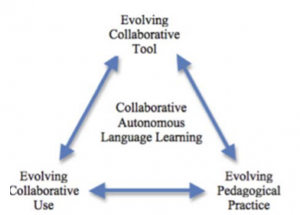In the odd semester last year, I decided to embed collaborative writing activity into my writing class. Thirty pre-service English teachers of a university in Indonesia were put into seven groups and were assigned into an eight-week collaborative writing project using Google docs. Each group was assigned to write two essays collaboratively on Google docs.I did not know what to expect because it was the my first time employing the strategy. Based on my observation, the students seemed to enjoy it; most group has good group dynamic in the sense that most group member contribute to the document. I decided to collect a simple qualitative data on the students perception about the strategy and their experience. Each student was asked to write an anonymous reflection essay about how they perceive the online collaborative writing activity. The essay was coded and analyzed. From the analysis, it was found that: (1) most students have positive perceptions toward the online collaborative writing activity even though they have problems with the internet connection and group dynamic, (2) students report changes in their perception about the activity before and after the project was completed.
But then, I was wondering whether the way I designed the collaborative writing activity was correct. I was also wondering if there is any framework I can use in designing a CALL- based collaborative writing activity; a framework that I can continue using in my teaching and research as I am interested in collaborative learning.Then I came across a learning model by Kessler et all (2012).
This framework grants the convenience to explore learning within the context of evolving tools, collaborations, and pedagogical practice. As Lund (2006) stated that technology changes the way language is taught. And what is fundamental in language learning is to empower and encourage our students to gain the knowledge, skills, and motivation to become autonomous language learners and culturally responsible participants in local and online communities (Godwin, 2015). I think I will use this framework as the base for designing the collaborative writing activity which considers a collaborative tool, collaborative use, adjusting pedagogical practice to meet the collaborative tool and use demands, and facilitating and encouraging autonomous language learning.

Figure 1. A framework for the co-evolution of collaborative autonomous pedagogy (Kessler et al., 2012)
References
Godwin, R. (2015). Emerging Technologies Contributing, Creating, Curating: Digital Literacies for Language Learners. Language Learning & Technology, 19(193), 8–20. Retrieved from http://llt.msu.edu/issues/october2015/emerging.pdf
Hubbard, P. (2013). Making a Case for Learner Training in Technology Enhanced Language Learning Environments. CALICO Journal, 30(2), 163–178. http://doi.org/10.11139/cj.30.2.163-178
Kessler, G., Bikowski, D., & Boggs, J. (2012). Collaborative writing among second language learners in academic web-based projects. Language Learning & Technology, 16(1), 91–109. Retrieved from http://www.academia.edu/download/30862473/kesslerbikowskiboggs.pdf
Lund, A. (2006). The multiple contexts of online language teaching. Language Teaching Research, 10(2), 181–204. http://doi.org/10.1191/1362168806lr191oa